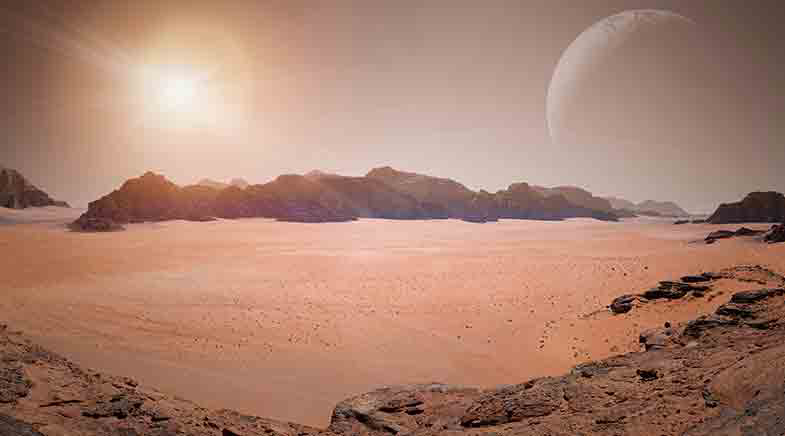Is there anybody out there?
-
- from Shaastra :: vol 01 issue 04 :: Jul - Aug 2022

Space programmes in search of extraterrestrial life are taking wing.
The world has opened up for coders interested in the quest for life beyond Planet Earth. Europlanet Society (EPS), a pan-European body aimed at furthering planetary research, including the hunt for extraterrestrial life, has launched a challenge for artificial intelligence (AI) and machine learning (ML) experts.
Through its Ariel Data Challenge 2022, which opened on June 30 and will be on till early October, EPS hopes that AI experts will help astronomers understand planets outside our solar system that could potentially support life.
The winners of the competition, backed by the U.K. Space Agency, will earn a cash prize and be invited to exhibit their presentation in New Orleans later this year.
Also supporting the contest is the European Space Agency (ESA), which plans to launch its Atmospheric Remote-sensing Infrared Exoplanet Large-survey (ARIEL) space telescope by early 2029. This will survey one-fifth of the 5,000 known exoplanets — planets that orbit a star outside the solar system.
It will study the light from each exoplanet's host star after it has travelled through the planet's atmosphere in what is known as a spectrum. This information can throw light on the make-up of the planet's atmosphere and its origins.
Advanced ML techniques may also help scientists understand the impact of different atmospheric phenomena on the observed spectrum.
TITAN'S TURN
Meanwhile, the U.S. National Aeronautics and Space Administration is planning a space mission to Saturn's natural satellite Titan, which is said to be very similar to early Earth. The 2026 mission will also look for clues on how life may have begun on Earth.
These exoplanet missions come at a time when researchers are finding new clues about extraterrestrial synthesis of organic molecules that are required to support life. For instance, astrophysicists associated with Germany's Friedrich Schiller University Jena have replicated in a lab a possible process by which peptides (polymers of amino acids) can be formed in interstellar medium.
While the possibility of synthesising amino acids in extraterrestrial environments was already proven, this work reported by Serge Krasnokutski and his team in Nature Astronomy moves a step forward.
Apart from suggesting a new and simple chemical pathway for peptide synthesis, the team proposed that peptides were the first large biomolecules present on early Earth.
“Therefore, it is very likely that peptides contributed in one or other way to the origin of life on Earth. This would also mean that peptides are continuously delivered to Earth and exoplanets. It increases chances of finding life on other planets,” Krasnokutski, who studies the formation of planets and stars, tells Shaastra.
Mimicking space-like conditions in the lab, the team synthesised peptides using three abundantly found substances in cosmic dust – ammonia, carbon monoxide and highly reactive atomic carbon.
The European Space Agency plans to launch its ARIEL space telescope, which will survey one-fifth of the 5,000 known exoplanets.
Carbon atoms work like molecular glue joining the carbon monoxide and ammonia molecules. "Due to the extremely high reactivity of single carbon atoms, this chemistry can take place at very low temperatures," Krasnokutski says.
The team also experimentally demonstrated that water molecules have no role in peptide synthesis. "Till recently it was assumed that water is essential for the formation of these biomolecules. We demonstrated that the removal of water from the chemistry only facilitates the formation of peptides. Removal of water allows us to skip two chemical steps, both of which have large energy barriers," he says.
The scientists now plan to study the formation of more complex peptides in astroconditions. Anoop Ayyappan, Associate Professor of Chemistry, Indian Institute of Technology Kharagpur, says that the origin of life on Earth could be a result of several possible intertwined pathways. What the German scientists have proposed is one such step.
"In this study, the authors are talking about a pathway for the formation of peptides other than the polymerisation of amino acids. This emphasises that the conventional wisdom of a bottom-up approach — such as peptides formed from amino acids — is not sufficient to understand the whole picture," Ayyappan says.
Ayyappan's team is trying to understand the prebiotic reaction in the solar system, particularly in Titan and Venus. "This is because the environments in these places are similar to the assumed environments in early Earth," he says.
They are exploring reactions between hydrogen cyanide and ammonia, simulating the atmosphere of Titan. "In these explorative studies, our algorithm will try to simulate several possible products from a reaction between two molecules… We hope to generate several molecules of astrobiological importance," he says.
Have a
story idea?
Tell us.
Do you have a recent research paper or an idea for a science/technology-themed article that you'd like to tell us about?
GET IN TOUCH














